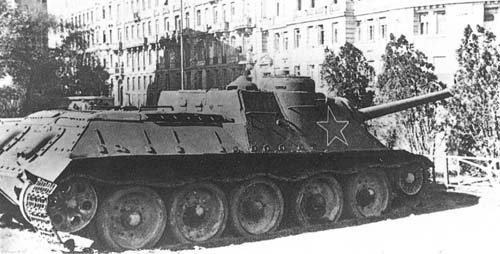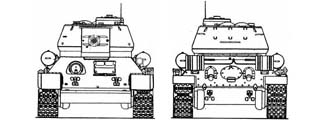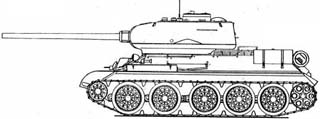T-34/85 medium tank
|
| Weigth |
32 tons |
| Crew |
5 |
| Weapons |
85mm L51,5 M43 or M44 gun with 55 rounds, 2
7,62mm DT MG with 2394 rounds |
| Armor |
hull 20-47mm (nose, sloped plate, sides and
rear 47mm, top and bottom 20mm); turret 20-75mm
(front, sides and rear 75mm, top 20mm) |
| Engine |
500hp diesel V2, 12-cylinders on V, liquid
cooled |
| Speed |
51Km/h |
| Autonomy |
354Km (with extra fuel supplies) |
| Length (max) |
8,15m |
| Width |
2,98m |
| Height |
2,65m |
|
Advantages: armor protection, mobility (autonomy, diesel
engine, speed, large tracks), powerful gun (adequate against the
Tigers and Panthers)
Disadvantages: none?
In action...
In late 1942 a T-34 with superior armor protection (and same
weaponry) was built but for the medium tanks the Russians were
searching for a superior fire power rather than more armor
protection to counter the new German machines.
 |
T-34/85 armor scheme (Photo by
Valera Potapov)
|
A new turret, similar to that designed for the KV-85, was
manufactured to fit on the standard T-34's chassis resulting in a
vehicle which had a far superior gun with and shape and armor's
thickness improved 3-men turret (with the useful commander's
cupola), mobility comparable with that of the other T-34s and the
same hull's armor. While first vehicles were equipped with the
D-5T gun, the most were built by using the ZIS-S-53 gun capable
of piercing a 95mm plate at 30º on a 914m range.
 |
T-34/85 in Heiligenbeil, East
Prussia, January 1945
|
When new T-34/85 came out (late '43) this assault gun was
obsolete and, from August 1944, it was replaced by the the more
powerful and suitable 31 tons SU-100 (100mm L60 gun and a side
commander's cupola on the T-34/85 chassis) in the Red Army's AT
battalions: this gun was capable to pierce a vertical 160mm thick
plate on a 914m range.
 |
SU-100 armor scheme (Photo by
Valera Potapov)
|
All of them were not equipped with MGs so close combat had to
be avoided or supported by strong infantry but because they were
used mostly for attacking difficult armored targets such the
Tiger heavy tanks or pillboxes this was not seen as a problem:
from 1,500 metres, its 34 pounds projectiles was able to pierce
Tiger's front plate.
 |
A SU-100 tank destroyer showing
its commander's cupola
|
The limited quantity of ammos carried inside did common
experience for the crew to store more ammunitions on the rear
deck, a dangerous practice when used in battle zones: this was an
usual Russian way because, due to their shortage of trucks
(Soviet industry was headed towards heavy mechanical production:
trucks and other vehicles were got mainly from the Western
Allies) and poor transport and communication ways. Their fighting
units used to carry as more supplies as they could with them, to
cover up to five days of continous offensive.

|
This page is online thanks to Geocities, the
largest Web Community! Get your own
free page at Geocities!!!
|






